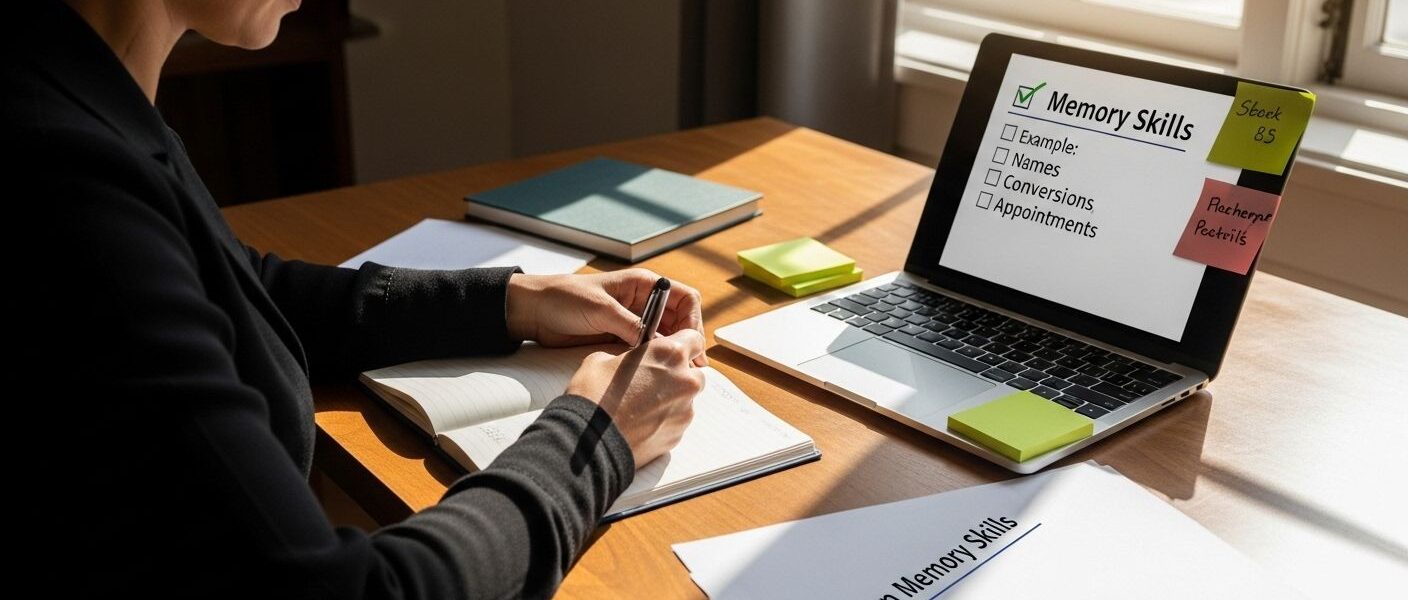
Everyone wants a sharper memory, yet most of us forget the little things every single day. Research shows that keeping a simple memory journal for just one week can reveal hidden patterns in your recall. Strangely enough, the trick to actually remembering more is not to push your brain harder, but to discover where it quietly slips up first—and that changes everything.
Quick Summary
| Key Point | Explanation |
|---|---|
| 1. Assess your current memory skills | Document your memory challenges for one week to identify strengths and weaknesses. This creates a baseline for improvement. |
| 2. Eat brain-boosting foods | Incorporate foods rich in omega-3s, antioxidants, and vitamins, like fatty fish and berries, to enhance cognitive performance and memory retention. |
| 3. Practice mindfulness daily | Engage in short meditation or mindfulness sessions to strengthen concentration and reduce stress, thereby improving memory capacities. |
| 4. Utilize mnemonic devices | Use techniques like acronyms and visual storytelling to make information more memorable and easier to recall. |
| 5. Regularly challenge your memory | Engage in various cognitive activities, such as puzzles and language learning, to strengthen memory and create new neural pathways. |
Step 1: Assign Your Current Memory Skills
Improving your memory begins with honest self-assessment. Before diving into advanced memory techniques, you need to understand your current cognitive baseline and recognize where your memory strengths and weaknesses reside. This foundational step helps you create a personalized strategy for memory enhancement.
Start by observing your daily memory performance across different scenarios. Track moments when you struggle to recall information, such as forgetting names, misplacing items, or struggling to remember recent conversations. Keep a memory journal for one week, noting specific instances of forgetfulness and the contexts in which they occur. Pay attention to patterns like whether you struggle more with short-term or long-term memory, verbal or visual recall.
Consider creating a simple self-evaluation framework. Rate your memory performance in key areas such as:
- Remembering names and faces
- Recalling recent conversations
- Tracking daily tasks and appointments
- Retaining new information during learning
- Navigating familiar and unfamiliar locations
Along with self-observation, seek external perspectives. Discuss your memory concerns with family members or close friends who can provide objective insights about your memory performance. They might recognize patterns or challenges you haven’t noticed.
For a more structured assessment, consider exploring memory evaluation techniques recommended by healthcare professionals. Some individuals might benefit from professional cognitive assessments that can provide detailed insights into memory functioning.
Remember, this assessment is not about criticism but understanding. Your goal is to create a compassionate, realistic roadmap for memory improvement. By documenting your current memory skills, you establish a baseline against which you can measure future progress. Learn more about personalized memory strategies to complement your self-assessment and prepare for the upcoming memory enhancement techniques.
Step 2: Incorporate Memory-Boosting Foods
Nutrition plays a critical role in supporting cognitive function and memory performance. Your brain requires specific nutrients to maintain optimal processing power, and strategic dietary choices can significantly enhance your memory capabilities. By selecting foods that support neurological health, you create a biological foundation for improved memory retention and cognitive performance.
Brain-friendly nutrition is about quality and variety. Focus on whole, nutrient-dense foods that provide essential compounds supporting neural connections and brain health. Green leafy vegetables like spinach and kale are memory powerhouses, packed with antioxidants and nutrients that help maintain cognitive function. Fatty fish such as salmon and mackerel offer omega-3 fatty acids critical for brain cell development and communication.
Berries emerge as particularly potent memory enhancers. Blueberries, strawberries, and blackberries contain flavonoids that improve blood flow to the brain and stimulate neurogenesis. These small fruits can help create new neural pathways and support memory formation. Complement berries with nuts like walnuts and almonds, which provide healthy fats and vitamin E that support overall brain health.
Your dietary strategy should include:
- Fatty fish rich in omega-3s
- Dark leafy green vegetables
- Colorful berries
- Nuts and seeds
- Whole grains
- Lean proteins
Consistent nutrition matters more than occasional dietary perfection. Aim to integrate these foods gradually, replacing processed snacks with brain-boosting alternatives. Hydration is equally important recognize that water supports cellular function and helps transport nutrients effectively.Discover comprehensive nutrition strategies that complement your memory enhancement journey. By treating food as cognitive fuel, you transform eating from a mere survival mechanism into a powerful tool for mental optimization.

Step 3: Practice Mindfulness and Meditation
Mindfulness and meditation represent powerful techniques for enhancing memory by training your brain to focus, reduce stress, and improve cognitive processing. These practices help create mental clarity, strengthen neural connections, and develop a more resilient cognitive framework. Your brain is like a muscle that becomes stronger with intentional exercise, and mindfulness serves as an essential workout for your mental capabilities.
Begin your mindfulness journey with simple, structured meditation practices. Start with short, manageable sessions lasting 5-10 minutes daily. Find a quiet space where you can sit comfortably without interruptions. Close your eyes and focus on your breath, observing its natural rhythm without attempting to control it. When your mind wanders, gently redirect your attention back to your breathing. This practice of returning to the present moment builds mental discipline and improves concentration.
Implement a consistent meditation routine by selecting a specific time each day. Morning meditation can set a focused tone for the day, while evening sessions help process accumulated mental information. Use smartphone apps or online guided meditation resources to support your practice if you find solo meditation challenging. Consistency matters more than duration – even brief daily sessions can yield significant cognitive benefits.
Your mindfulness techniques should include:
- Focused breathing exercises
- Body scan meditations
- Mindful walking
- Seated quiet reflection
- Guided visualization practices
Expect initial challenges as your mind resists new patterns. Some days will feel easier than others, and that’s normal. Approach your practice with curiosity and compassion, treating each meditation session as a learning opportunity rather than a performance evaluation. Track your progress by noting improvements in concentration, emotional regulation, and memory recall.Learn advanced concentration techniques that complement your mindfulness practice. As you continue this mental training, you’ll develop a more resilient and adaptable cognitive system capable of improved memory retention and processing.
Step 4: Use Mnemonic Devices Effectively
Mnemonic devices transform memory from a challenging task into an engaging mental game, providing powerful techniques to encode and recall information more effectively. These cognitive tools leverage your brain’s natural ability to connect new information with familiar concepts, making memory retention significantly easier and more enjoyable.
The art of creating memorable connections begins with understanding different mnemonic strategies. The acronym method allows you to convert complex information into memorable word formations. For instance, to remember the order of planets, use “My Very Educated Mother Just Served Us Nachos” where each word’s first letter represents Mercury, Venus, Earth, Mars, Jupiter, Saturn, Uranus, and Neptune. The visual association technique takes this further by creating vivid, sometimes absurd mental images that link key information, making recall more intuitive.
Personalize your mnemonic approach by selecting methods that resonate with your learning style. Some individuals excel with rhythmic techniques like songs or rhymes, while others prefer visual storytelling. Experiment with multiple approaches to discover which strategies feel most natural and engaging for you. Practice converting dry, abstract information into vibrant mental narratives that stick in your memory.
Below is a table summarizing popular mnemonic device options and their key characteristics to help you choose techniques that fit your personal memory style.
| Mnemonic Technique | Description | Best For |
|---|---|---|
| Acronym Creation | Build words using the first letters of target items | Memorizing lists (e.g., planets, processes) |
| Visual Storytelling | Link information with vivid mental images | Visual learners and abstract concepts |
| Rhyme and Rhythm | Use rhyming phrases or songs to encode info | Sequential data and younger learners |
| Location-Based Mapping | Place data in imagined physical locations (loci) | Recalling sequences or ordered information |
| Chunking | Group information into smaller, meaningful units | Phone numbers, ID numbers, long lists |
Your mnemonic toolkit should include:
- Acronym creation
- Visual storytelling
- Rhyme and rhythm techniques
- Location-based memory mapping
- Chunking complex information
Consistent practice is crucial for mastering mnemonic techniques. Start with small, manageable pieces of information and gradually increase complexity. Challenge yourself to create increasingly creative and memorable associations. Remember that the more emotionally engaging or surprising your mnemonic, the more likely you are to remember it.Explore advanced learning strategies that complement your mnemonic skill development. By transforming memory from a chore into an intellectual adventure, you unlock your brain’s remarkable potential for information retention and recall.
Step 5: Regularly Challenge Your Memory
Making your memory stronger requires intentional and consistent cognitive challenges that push your brain beyond its comfort zone. Like physical muscles, your memory improves through strategic exercise and progressive difficulty. The key is selecting activities that simultaneously engage multiple cognitive domains, forcing your brain to create new neural pathways and strengthen existing connections.
Start by incorporating puzzle-based activities that demand different mental skills. Sudoku, crossword puzzles, and logic games provide excellent memory workouts by requiring concentration, pattern recognition, and problem-solving. Chess and strategic board games offer complex mental challenges that train your working memory and strategic thinking simultaneously. Rotate through various puzzle types to prevent mental adaptation, ensuring your brain remains stimulated and engaged.
Language learning emerges as a powerful memory enhancement technique. Learning a new language challenges your brain to create complex neural networks, improving memory plasticity and cognitive flexibility. Begin with smartphone apps or online language platforms that offer interactive, bite-sized lessons. Commit to consistent practice, even if it’s just 15 minutes daily. The process of memorizing vocabulary, understanding grammar structures, and practicing pronunciation creates a comprehensive mental workout.
Your cognitive challenge toolkit should include:
- Strategic puzzle games
- Language learning platforms
- Musical instrument practice
- Complex board games
- Digital brain training apps
Track your progress by maintaining a cognitive challenge journal. Note the activities you attempt, your performance, and subjective difficulty levels. This documentation helps you understand your cognitive strengths and areas requiring more focused development.
This table outlines recommended types of cognitive challenges for regular memory training, along with the target cognitive skills each one develops and example activities mentioned in the article.
| Challenge Type | Target Skills | Example Activities |
|---|---|---|
| Puzzle-Based Games | Logic, pattern recognition, strategy | Sudoku, crossword puzzles, logic games |
| Language Learning | Memory, attention, flexibility | Language apps, learning new vocabulary |
| Musical Instrument Practice | Coordination, auditory memory | Learning a song, practicing scales |
| Board Games & Strategy | Working memory, planning, reasoning | Chess, strategic board games |
| Digital Brain Training | Speed, visual memory, adaptation | Brain training apps, online challenges |
Discover scientifically proven memory improvement techniques that complement your memory challenge strategy. By consistently pushing your cognitive boundaries, you transform memory improvement from a theoretical concept into an engaging, dynamic personal journey.
Step 6: Evaluate Your Progress and Adjust Strategies
Effective memory improvement is not a linear journey but a dynamic process of continuous assessment and strategic refinement. Tracking your cognitive progress requires a systematic yet flexible approach that allows you to understand what techniques work best for your unique brain and learning style. This step transforms your memory enhancement from a rigid plan into an adaptive, personalized strategy.
Create a comprehensive memory tracking system using a dedicated journal or digital spreadsheet. Document each memory technique you attempt, noting specific details like duration of practice, difficulty level, and subjective experience. Record quantitative metrics such as the number of items you can recall in memory exercises, time taken to memorize information, and instances of successful recall in daily life. Consistency in documentation reveals patterns that might otherwise go unnoticed, helping you identify your most effective memory strategies.
Implement periodic self-assessment checkpoints. Every month, review your memory tracking data and conduct focused memory tests. These tests can include recall exercises like memorizing a list of random words, remembering a sequence of numbers, or reciting details from a recently read article. Compare your performance against previous results to gauge improvement. Be compassionate with yourself during this process understanding that memory enhancement is a gradual, nonlinear progression.
Your progress evaluation toolkit should include:
- Detailed memory practice journal
- Monthly self-assessment tests
- Periodic strategy adjustment sessions
- Performance tracking spreadsheet
- Reflection on learning techniques
Remain open to experimenting and pivoting your approach. Some techniques that initially seem ineffective might reveal their value over time, while others might lose effectiveness as your brain adapts. Approach your memory enhancement journey with curiosity, treating each challenge as an opportunity for learning and growth. Pay attention to how different lifestyle factors like sleep, nutrition, and stress levels interact with your memory performance.Learn more about tracking personal learning strategies to refine your memory improvement approach. By developing a reflective, data-driven methodology, you transform memory enhancement from a mysterious process into a clear, manageable path of continuous cognitive development.

Ready to Transform Your Memory Skills?
If you have ever felt frustrated by forgetfulness or struggled to recall important details despite your best efforts, you are not alone. The strategies in this article highlight real challenges, like tracking daily information, mastering memory techniques, and building sustainable habits for lasting improvement. Ultra News offers more than just educational articles. We provide an entire section dedicated to practical guides and up-to-date resources so you can actively boost your memory and stay informed with the latest advice on technology and lifestyle.

Take the next step in your journey. Visit Ultra News to explore new memory tools, read expert guides on learning strategies, and find the support you need to reach your cognitive goals today. Do not wait to unlock your potential—start building a sharper, more resilient memory with trusted and easy-to-understand resources from Ultra News.
Frequently Asked Questions
How can I assess my current memory skills?
You can assess your memory skills by keeping a memory journal for a week, noting instances of forgetfulness and tracking your abilities in remembering names, recalling conversations, and retaining new information.
What are some foods that can help improve memory?
Incorporate brain-boosting foods such as fatty fish rich in omega-3s, dark leafy vegetables, colorful berries, nuts, whole grains, and lean proteins to support cognitive function and memory performance.
How does mindfulness and meditation enhance memory?
Mindfulness and meditation improve memory by training your brain to focus, reduce stress, and enhance cognitive processing. Regular practice creates mental clarity and strengthens neural connections.
What are effective mnemonic devices for memory retention?
Effective mnemonic devices include creating acronyms, using visual storytelling, employing rhythm and rhyme, and utilizing location-based memory mapping. These techniques help encode and recall information more easily.




